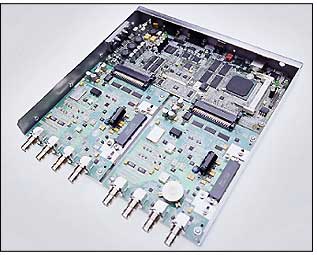Jul 01, 2004A debate has been brewing within the RFID industry for a couple of years over whether end users will want to deploy dumb RFID readers that read tags and simply pass the data on to other systems or smart readers that can filter data, execute commands and perform other functions. ThingMagic has been a leading proponent of smart readers, and its new Mercury4 represents a big bet on which way the market is headed.
The Mercury4 features an Intel IXP4XX network processor, which, the company says, makes it able to process data faster than any other reader on the market. The device runs on the Linux operating system and comes with a number of PC-like functions built in. The Mercury4 can, for instance, run its own database that applications can run queries against (example: "provide a list of all tags starting with A123 that have been read in the past hour"). Companies and third-party software developers can also write applications to run on the reader.
In addition, the new reader supports standard networking protocols including DHCP, UDP/IP over Ethernet, 820.11x (Wi-Fi), HTTP and SNMP. "Our device is built to be a full-fledged citizen on the IT infrastructure," says Tom Grant, the chairman and CEO of ThingMagic, which is based in Cambridge, Mass. "We can update the devices remotely. We've designed it for deployment. We thought long and hard about what's going to make a CIO comfortable with this reader on the corporate network."
The Mercury4 also has a 300 MHz Texas Instruments digital signal processor running ThingMagic firmware. The reader can currently read UHF tags that are based on EPC Class 1 and Class 0, ISO 18000-6B and Philips UCODE EPC 1.19. The company says that the firmware for the reader can be upgraded remotely as new protocols, including the proposed EPC UHF Gen 2 standard, emerge.
Like ThingMagic’s earlier Mercury3 model, the new reader uses a software radio architecture for its readers, which means that software is used to create a digital signal and then a digital-to-analog converter turns the signal into an analog wave. The advantage of this approach is that when "air-interface" protocols (the way tags and readers communicate) change, the software can be upgraded remotely.
The reader provides flexibility in other ways, as well. Different transceiver modules—printed circuit boards that can be swapped in and out—can be used for reading tags at 915 MHz in the United States, 868 MHz in Europe and 960 MHz in Japan. (The modules for Europe and Japan will not be available until European Union and Japanese regulations surrounding the use of UHF RFID systems are finalized.)
The reader also has a module for reading high-frequency (13.56 MHz) tags. So an end user company could purchase a reader with four UHF modules, which supports eight reader antennas. Or it could purchase readers with a mix of UHF and HF modules, depending on the application the readers are being used for.
"The need for two, four or eight reader antennas varies based on where a company is reading the tags," says Grant. "It's becoming clear as companies begin deploying the technology, they want that flexibility, as well as the ability to swap out modules based on the geographical area where they will be using the readers."
ThingMagic doesn't manufacture the readers itself. Instead it licenses the reader design to other companies that make the readers. So far, two companies have signed up to make readers based on the Mercury4 design. Tyco International will sell the readers through its ADT division and market them under its Sensormatic brand. The other company is Omron, a large Japanese RFID systems provider. Both companies are expected to have Mercury4-based readers commercially available before the end of the year.
The big downside that end users see in an intelligent reader is that it tends to cost more. But Grant argues that the total cost of ownership of an intelligent reader can be lower than a dumb reader because an intelligent reader can be monitored and upgraded remotely.
"Much of the intelligence is in the software, so in the long term, I don't think there will be a substantial difference in price [between our readers and dumb readers]," says Grant.
Pricing for readers based on the Mercury4 design will be set by the companies that license the design and manufacture the devices. In the short term, those readers might be more expensive than simple readers because of the higher cost of the Intel processor and other components, but Grant believes that the price of those components will fall as volumes ramp up. And he argues that the ease of upgrading and maintaining smart readers will make the total cost of ownership cheaper in the long term.


